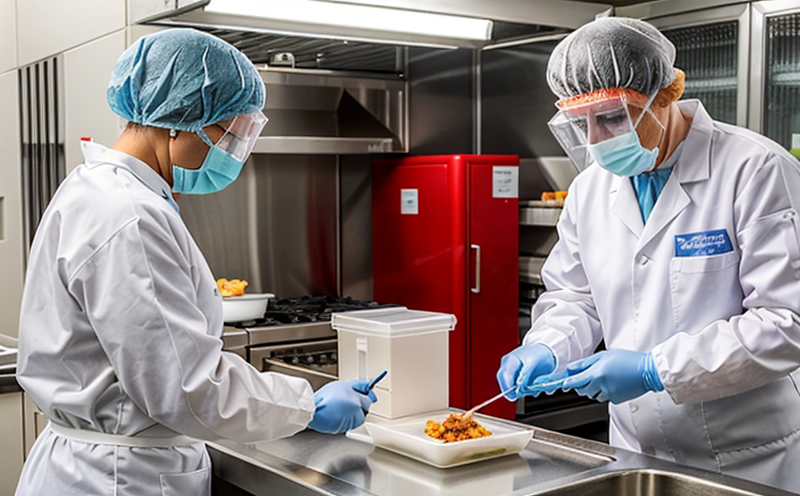ISO 15216-1 Detection of Norovirus and Hepatitis A Virus in Food by RT-PCR
The detection of norovirus and hepatitis A virus in food is critical for maintaining public health and ensuring food safety. ISO 15216-1 provides a robust framework for the detection and quantification of these pathogens using Reverse Transcription Polymerase Chain Reaction (RT-PCR) methods. This service ensures that food products are free from harmful viruses, thereby protecting consumers.
Foodborne viruses like norovirus and hepatitis A virus are significant global health concerns. They can cause severe gastrointestinal illnesses and have led to numerous outbreaks worldwide. Accurate detection of these viruses is crucial for preventing further contamination and ensuring the safety of the food supply chain. Our laboratory adheres strictly to ISO 15216-1 standards, which outline precise protocols and quality control measures.
The process begins with proper sampling and specimen preparation. Samples are collected from various parts of the food production chain, including raw materials, processing environments, finished products, and packaging. Specimens must be handled carefully to avoid contamination. Once collected, they undergo a series of steps to extract nucleic acids, which are then subjected to RT-PCR analysis.
The RT-PCR method used in this service involves several key steps: reverse transcription, amplification, and detection. Reverse transcription converts viral RNA into complementary DNA (cDNA), making it suitable for PCR amplification. The amplified DNA is then detected using real-time PCR technology, which provides a quantitative measure of the virus concentration.
Our laboratory uses state-of-the-art instruments such as ABI 7500 Fast Real-Time PCR Systems and Agilent Technologies QX102 Droplet Digital PCR Systems to ensure accurate and reliable results. These instruments are complemented by advanced bioinformatics tools that analyze the data and generate comprehensive reports.
The scope of this service extends beyond just detection; it also includes quantification, which is essential for understanding the extent of contamination. Quantitative measurements help in identifying potential sources of infection and implementing targeted interventions. The results provide valuable insights into food safety practices and inform corrective actions to prevent future outbreaks.
Our commitment to quality and reliability ensures that every test conducted meets international standards. This service not only adheres to ISO 15216-1 but also follows other relevant guidelines such as FDA, EU regulations, and WHO recommendations. By doing so, we ensure that our clients receive accurate, consistent, and compliant results.
Why It Matters
The detection of norovirus and hepatitis A virus in food is not just a technical exercise; it has profound implications for public health. These viruses are highly contagious and can spread rapidly through contaminated food, leading to widespread outbreaks. The consequences of such outbreaks include increased healthcare costs, lost productivity, and potential damage to brand reputation.
By ensuring that food products comply with ISO 15216-1 standards, we contribute to a safer food supply chain. This service helps protect consumers from the risks associated with foodborne viruses, thereby promoting trust in the food industry. Compliance with these standards also facilitates international trade by meeting regulatory requirements in different countries.
The economic impact of preventing outbreaks is substantial. The cost of managing an outbreak can be enormous, including the expenses for tracing contaminated products, recalling affected items, and implementing corrective measures. By providing reliable testing services, we help minimize these costs and support sustainable business practices.
Scope and Methodology
| Step | Description |
|---|---|
| Sampling | Careful collection of samples from various parts of the food production chain. |
| Nucleic Acid Extraction | Use of appropriate methods to extract RNA from the sample. |
| Reverse Transcription | Conversion of viral RNA into complementary DNA using reverse transcriptase enzymes. |
| PCR Amplification | Amplication of the extracted DNA for subsequent analysis. |
| Detection | Real-time PCR technology used to quantify the virus concentration. |
The methodology ensures that every step is performed with precision and accuracy. This comprehensive approach guarantees reliable results, which are essential for making informed decisions regarding food safety.
Quality and Reliability Assurance
- Strict adherence to ISO 15216-1 standards.
- Use of validated reagents and kits.
- Regular calibration of instruments.
- Training of personnel on the latest techniques.
- Implementation of strict quality control measures.
Our laboratory is dedicated to maintaining high standards of quality and reliability. We continuously monitor our processes and results to ensure they meet or exceed international standards. This commitment to excellence ensures that our clients receive accurate, consistent, and compliant test results.





